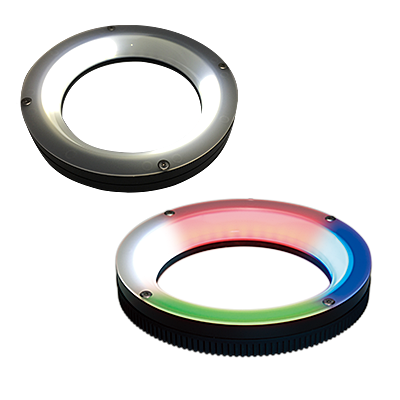
Segmented Ring Lights
* Has a very diffused output and comes with four independently controllable quadrants.
* Ideal for your typical Photometric Stereo applications or High Dynamic Range applications.
* 7 different sizes and in 4 different wavelengths per size.
Feature
- Has a very diffused output and comes with four independently controllable quadrants.
- Ideal for your typical Photometric Stereo applications or High Dynamic Range applications.
- 7 different sizes and in 4 different wavelengths per size.
Applications
Photometric Stereo (PMS)
Photometric stereo allows the user to separate the shape of an object from its 2D texture. It works by firing segmented light arrays from multiple angles and then processing the resulting shadows in a process called “shape from shading.” It is useful for the detection of small surface defects and 3D surface reconstruction. PMS is a height driven process which can enhance surface details like scratches, dents, pin holes, raised printing, or engraved characters. Because the final image is a computed surface based on the shading information surface coloring or features without height are removed.
This can make visually noisy or highly reflective surfaces easier to inspect. This capability is rapidly becoming popular in the MV market. Numerous machine vision suppliers are offering photometric stereo tools. A basic PMS system uses a ring light with four 90 degree quadrants to cast a directional shadow around raised features on an object. The feature map can be applied through different algorithms to show surface details that are hard to find or can’t be detected in pure visual images.
Tire inspection with PMS
The images in this example were captured with a ring light with four 90 degree quadrants. The quadrants were fired in sequence to create the West, North, South, and East images as shown on the right. Images of the Tire Texture and Tire Shape are then created by combining these images in software as shown. The PMS routine removes the visual noise and leaves only the features of interest.
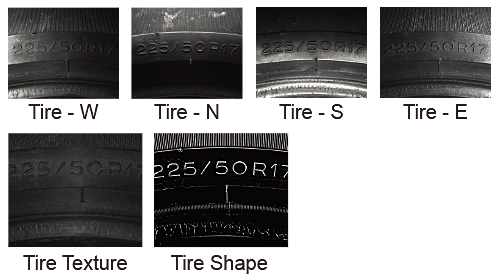
High Dynamic Range (HDR)
All imagers have a limit to the ratio of the brightest object to the darkest object that can be distinguished in a single image. This is called the dynamic range. Many machine vision applications involve bright, shiny, or dark objects that challenge the dynamic range of the camera. To solve these cases, a series of images with different exposure levels can be captured to create a single HDR image with all the detail that needs to be included for the inspection.
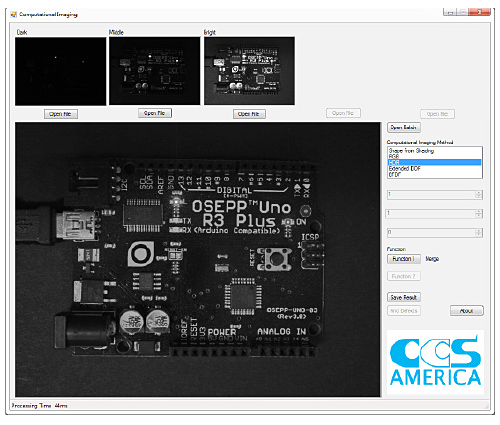
HDR imaging
This HDR image is created from 3 images with different exposures. Image 1 lets you see the LED die and surrounding package, but no other details are visible. Image 2 exposure allows the silkscreen and brightest parts of the components to be seen, but the LED is oversaturated.
This HDR image is created from 3 images with different exposures. Image 1 lets you see the LED die and surrounding package, but no other details are visible. Image 2 exposure allows the silkscreen and brightest parts of the components to be seen, but the LED is oversaturated. Image 3 allows the barrel connector and other dark components to be seen, but the text and component leads are oversaturated; the LEDs are completely washed out. The HDR image allows correct exposure of the bright LEDs, proper saturation of the silkscreen and component leads, yet the dark components can still be seen.
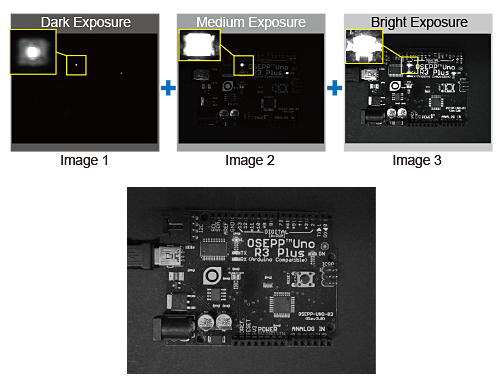
Controller
LSS-2404
The LSS-2404 Light Sequencing Switch is a special-purpose programmable LED Lighting controller designed to switch external +24 VDC power for up to 4 channels of lights. Upon receiving an external system trigger, the LSS- 2404 executes a pre-programmed sequence of lighting on the 4 channels and outputs a set of correlated camera triggers, automatically synchronizing a series of external camera exposures to the programmed lighting sequence. Arbitrarily complex lighting sequences are possible to support any combination of Computational Imaging (multi-shot) and conventional (single-shot) image capture. Bundled software allows the user to configure the controller and update the firmware.
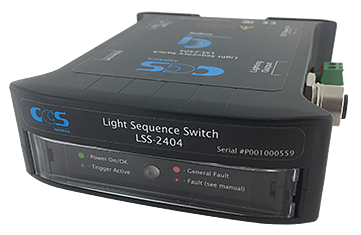
Products
-
Machine Vision Applications
Ring
Square
Bar (Area)
Flat
Dome
Cylinder
Box
Spot
Line (Convergent Lighting)
Line (Diffused Lighting)
Line (Oblique Angled Lighting)
UV Lights [Ultraviolet Lighting] / Violet Light
IR Lights [Infrared Lighting] (under 1000nm)
Custom Order Product
Intensity Control Units [Light Units with Intensity Control Unit ]
OLED(CCS-LT)
Effilux Products
Basler Camera Light Series
- BCL Series (Bar Light)
- BCR Series (Ring Light)
- BCBL Series (Flat Light)
- BCF Series (Flood Light)
- BCL Series (Bar Light) Diffusion Plates
- BCR Series (Ring Light) Diffusion Plates
- BCF Series (Flood Light) Transparent Plate
- BCL Series (Bar Light) Light Polarizing Plates
- BCR Series (Ring Light) Polarizing Plates
- BCF Series (Flood Light) Polarizing Plates
- BCR Series (Ring Light) Light Adapter
- BCL Series (Bar Light) Light Bracket
- Basler Camera Light dedicated cable
IR Lights [Infrared Lighting] (over 1000nm)
Reference Light Source
-
Agri-Bio Lighting
LED Light Units for Plant Research
ISL-150X150 Series Unit
ISL-150X150 series cables
-
Human Vision Inspection and Microscope Applications
LED Light Units for Microscopes
-
Power Supplies
High Power Strobe Control Unit
Digital Control Units
Analog Control Units
Building Block Types
LED Light Controller
Control Units [for the HLV Series]
Strobe Unit
High-capacity Analog Control Unit
High-capacity Constant-current Control Units
Controller with EtherNet/IP Interface
PoE Enabled Controller
Control Units [for CCS AItec]
-
Cables
Extension Cable [for PF Series]
Straight Cables
2-way Cables [EL connector type]
4-way Cables
Robot Cables
Straight Cables [EL connector type]
2-way Cables [EL connector type]
Straight Cables for metal connector (7 pins)
Straight Cables for metal connector (37 pins)
Straight Cables for M12 connector
External Control Cables
Relay Connector
-
Options
Filters
Polarizing Plates
- Polarizing Plates [for IR Series Infrared Lights (over 1000-nm type)]
- Polarizing Plates [for HLDL3 Series]
- Polarizing Plates [for LB Series]
- Polarizing Plates [for LDR-PF Series]
- Polarizing Plates [for LDL-PF Series]
- Polarizing Plates [for Ring Lights]
- Polarizing Plates [for Bar Lights]
- Polarizing Plates [for Coaxial Lights]
- PL Series (FASTUS)
Diffusion Plates
- Diffusion Plates [for HLDL3 Series]
- Diffusion Plates [for LB Series]
- Diffusion Plates [for LDR-PF Series]
- Diffusion Plates [for LDL-PF Series]
- Diffusion Plates [for Ring Lights]
- Diffusion Plates [for Low-angle Ring Lights]
- Diffusion Plates [for Bar Lights]
- Diffusion Plates [for Coaxial Lights]
- DF80 Series
- DF Series
- Diffusion Plates [for LDR-PF-LA Series]
- DF-ISL-165X165 Series
Light Control Films
Adapter [for the CSR Series]
Lens Attachment Rings
Fixtures
Converter
Protective Plates
Coaxial Units
Fixtures
Reflection Plate
Condenser lens
-
Lenses
Telecentric Lenses
Macro Lenses


 Request Free Trial
Request Free Trial Request Quotation
Request Quotation Inquiry Form
Inquiry Form Locations
Locations